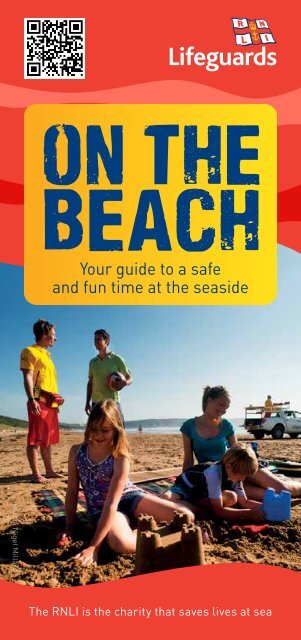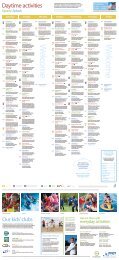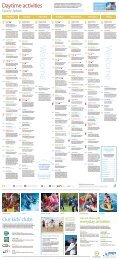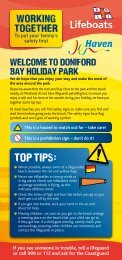Beach Safety - Haven Holidays
Beach Safety - Haven Holidays
Beach Safety - Haven Holidays
- No tags were found...
You also want an ePaper? Increase the reach of your titles
YUMPU automatically turns print PDFs into web optimized ePapers that Google loves.
Your guide to a safeand fun time at the seasidePhoto: Nigel MillardThe RNLI is the charity that saves lives at sea
OUR AIM AT THERNLI IS TO ALWAYSPUT LIFE FIRSTHello!You’ll be pleased to hear that our lifeguard and lifeboatcrews will be looking out for your safety while youenjoy a well-deserved break at the beach.You can find out more about our lifesavers in thisbooklet and read about a couple of real-life rescues –but mostly this guide is about making your day at theseaside even more enjoyable. It’s full of hints and tipsfrom us and our friends at the Marine ConservationSociety to help you enjoy a safe and fun day at thebeach. For more information on beach safety visit:RNLI.org.uk/beachsafety. Enjoy!The BBC’s Seaside Rescue narratorCaroline Quentin says:‘As a mother to two children, I alwaysconsider safety when visiting a beachand, whenever possible, go to a lifeguardpatrolledbeach.‘Having RNLI lifeguards nearby isreassuring. We can get on with our fun,knowing they are on hand just in case weneed to ask for advice,help with first aid or evenmissing children.‘And should there be areal emergency, you knowthat with their professionaltraining, fitness and aboveall courage, they will bethere for you.‘I would urge peopleto take a moment to readthis invaluable guide fromthe RNLI.’In this guide you will see two types of warning symbol:This is a hazard to watch out for – take care!This is a prohibition sign – don’t do it!
TRUE STORYSally Cole and her sons Jack (15) and Toby (12) willnever forget their holiday in August ...‘We were enjoying a family holiday with friends atMawgan Porth. The beach was busy and the water washeaving. We were swimming and bodyboarding betweenthe flags when we were suddenly caught in a rip current.‘One minute the water was at waist level, the nextmy feet couldn’t find the bottom. My son Jack just shotstraight out to sea, along with our friend Colin, his sonand some others. Colin and I are both strong swimmersand I used to be a pool lifeguard so it was such a shockthat I was out of my depth so quickly. I was being pulledunder and out, and was really fighting large waves everytime I came up.‘We were really glad to see the lifeguards who broughtJack in, along with our other friends, and checked I wasokay on the way through. Luckily, my other son Toby hadpaddled out to me and two other ladies so we could grabonto his bodyboard until the lifeguards could come backfor us. He was remarkably calm considering! All in allI reckon the lifeguards must have picked up 11 peopleduring that rescue. We were all incredibly grateful.‘If I could give a piece of advice to others it would bethat you absolutely need to be swimming on a lifeguardedbeach, especially if there is a large group of you withteenagers. Also, it’s probably worth having a bodyboardto help you keep afloat should something go wrong. Mostimportantly – don’t panic!’Sally Cole and family with the lifeguards at Mawgan PorthPhoto: Lewis Timson
RIP CURRENTSRips are strong currents that can quickly takeswimmers from the shallows out beyond their depth.Lifeguards will show you where you can avoidrips but if you do get caught in one:stay calm – don’t panicif you can stand, wade don’t swimkeep hold of your board or inflatable to helpyou floatraise your hand and shout for helpnever try to swim directly against the rip or you’llget exhaustedswim parallel to the beach until free of the rip,then make for shoreif you see anyone else in trouble, alert thelifeguards or call 999 or 112 and ask for theCoastguard.IncomingwavesRip headIncomingwavesSwim parallel to shoreRip channelDirectionof current<strong>Beach</strong>
SUN SAFETYSunburn can ruin your holiday andincrease the risk of skin cancer in laterlife. According to our friends at the Karen CliffordSkin Cancer Charity, Skcin, we experience over halfour lifetime’s exposure to the sun before we reach theage of 21.So please, keep your family safe this Summerand follow the five Ss of sun safety:Sunscreen – slop on SPF 30+ broad-spectrum,UVA 4 star+ rated, waterproof sunscreen every2 hours. Waterproof sunscreens should notbe used on children under 3 years as it canstop them sweating and lead to overheatingSun hat – slap on a broad-brimmed hat thatshades your face, neck and earsSunglasses – wear wrap-around sunglasseswith UV protection to shield your eyesShoulders – slip on a T-shirt or UV protectivesuit for children and remember to keep yourshoulders coveredS h a d e – seek shade, particularly during thehottest time of the day between 11am and 3pmwhen UV penetration is at its strongest.For more info on sun safety visit skcin.org
FAMILYFUNThe RNLI has teamed up with the Marine ConservationSociety (MCS) to help keep our beaches safe and cleanfor people and wildlife. MCS recommends you visitgoodbeachguide.co.uk to discover Britain’s best beachesand avoid swimming in dirty water.When you’ve arrived at your chosen beach, exploringthe seashore is fantastic fun for all the family. You canfind a new world of wildlife in shallow pools amongboulders and sands, most of which is beautiful andharmless. But it’s worth being well aware of the fewanimals that can cause a painful injury. You can see themost common opposite. For all of these, MCS advises:‘Look, but don’t touch’ and asks you to remember:leave animals where you find themcarefully lift and replace any rocks you may haveremoved – there are animals underneath that needthem for shelterleave attached seaweed in place – there is plentylying loose on the shorelinedo not trample through the rock poolsplay away from cliffs.ENVIRONMENTOur coast is spectacularly beautiful, rich in wildlife andhugely popular, drawing people from a considerabledistance for a range of recreational activities. Manysites are protected for their special wildlife interest andinclude a variety of rare and protected species frommarine mammals to plants, birds and insects.Depending on where you are in the UK, take a look atthese websites to find out if the beach you’re visiting isin a protected site and what habitats and species youmight find:Natural England www.naturalengland.org.ukCountryside Council for Wales www.ccw.gov.ukNorthern Ireland Environment Agencywww.ni-environment.gov.ukScottish Natural Heritage www.snh.gov.uk
TREATING A STINGWeever-fishThese are plain-looking fish thatsometimes nestle in the sand,in water just a few centimetresdeep. A weever-fish will raise asharp spine on its back in selfdefence if trodden on – ouch! Place the affected areain water as hot as you can stand. Test the water firstso as not to scald the person who has been stung.JellyfishIf you are stung by a jellyfish, donot rub as this will cause the painto increase. Lightly spray the areawith sea water and apply a coldcompress if available. If severeand or life-threatening symptoms are present, seekmedical attention immediately. If you spot a jellyfish,you can report it to the MCS at mcsuk.org.Sea anemonesYou can find sea anemones stuckon rocks. These are soft-bodiedcreatures that can producea nasty rash if brushed against– though most people won’tbe affected.Photo: Paul NaylorPhoto: RNLI/Nigel Millard
MISSING CHILDRENChildren are safest when supervised.As soon as you get to the beach, agree a meetingpoint in case of separation. If the beach runs achildren’s safety scheme, using wristbands ortickets, take part. They’re free and they work.If you are on an RNLI-lifeguarded beach, pay avisit to the lifeguard hut on arrival and they can giveyou special wristbands on which you can put yourcontact details.If a child does go missing:calmly check your surroundings first, ensuringother children remain monitoredcontact the lifeguards or police and keep theminformedlet all searchers know once the child is found.INFLATABLESBlow-up toys and airbeds are designed for pools,not the sea where they can easily be swept out.If you must use them at the beach, then:ensure children are closely supervisedkeep nearbyonly use between the red and yellow flagsfollow the lifeguard’s advicedo not take out in big wavesdo not use when orange windsock is flying,as this indicates offshore winds.
HERE ARE SOME FUN, FREE GAMESTHAT CAN BE PLAYED AT THE BEACH:FLAGS GAMEThis game is used by lifesaving clubs with small children,but is also an international competitive lifesaving sportand is used as part of lifeguard fitness training.The ‘flags’ are sticks (blunt!) with something tied tothe top, or proper sandcastle flags, poked into the sand.Lie on the sand, face down and heads away from theflags. At a given signal, leap up and run to grab a flag.Make sure there are always one or two fewer flagsthan people playing, so the slowest are eliminated,just as in musical chairs. This goes on until only oneperson remains.SCAVENGER HUNTChoose a theme to make your collection more exciting.Focus on natural objects or man-made ones but keepaway from the sharp and spiky. Try finding something onthe beach beginning with each letter of the alphabet. Ormake a collection of particular colours – you could builda rainbow with your finds!If you’ve collected litter – thank you! Otherwise, makesure you leave your finds on the beach at the end of theday as they are part of the natural environment.BEACH OLYMPICSWet sand makes a great Olympic arena! Draw somelines in the sand to mark out your own tracks, courtsand pitches. As well as all the athletic events – running,jumping, throwing – how about inventing some variationsof your own?Human obstacle courseEach person becomes an obstacle for the rest of thefamily to climb over or jump across. When you’vecompleted your go, form a new obstacle, and theline continues. The ‘obstacles’ can give the ‘racers’instructions on how the obstacle is to be negotiated.Blanket volleyballYou’ll need a beach ball or football and picnic rug forthis one. Everyone holds the edges of the blanket with theball in the middle. You have to work together to move theball – see how high or how far you can throw it only usingthe blanket.
SURF HIRE SAFETY SCHEMEIn recent years, over 40% of RNLI lifeguard assistancehas been boarding-related. The Surf Hire <strong>Safety</strong> schemewas a joint venture between the RNLI and the BritishSurfing Association, which aimed to reduce such incidents.Scheme members have agreed:to only rent out equipment suitable to abilityto provide safety information to all customersto check equipment regularly for damageto maintain adequate insurance.So look out for the logo and choose a schememember when hiring your board. For moreinformation visit surfhiresafety.co.uk.TIDESA beach can seem like a vast playground, but the tidecan come in surprisingly quickly. Many lifeboat andlifeguard rescues are to people getting cut off by therising water. To prevent this happening to you, getlocal tidal information from the Harbour Master orthe Tourist Information Centre, or visit:bbc.co.uk/weather/coast/tides.Always keep a look out for the direction of the tidewhile on the beach. Just be aware … and if in doubt,move out!TOMBSTONINGJumping from heights into water is dangerousbecause:water depth alters with the tide – it might beshallower than you thinksubmerged objects like rocks may not be visibleit can be really cold and the shock makes itdifficult to swimthere can be strong currents that might sweepyou away.Many people have been seriously hurt or evenkilled due to tombstoning. Our advice is not to doit at all.
AT HOMEPerhaps it’s a bit rainy today and you can’t make it to thebeach. Don’t worry – here are a couple of seaside puzzlesto keep you busy.QUIZ1. How many crew are there usually in a lifeguard’sinshore rescue boat?2. What is a ‘mermaid’s purse’?3. Which is the biggest ocean?4. What does ‘submerge’ mean?5. What does the red flag mean at a beach?6. What do you call a collection of jellyfish?7. What is a neap tide?8. What does an orange sock on the beach mean?9. What is bladder wrack?10. What colours are the RNLI lifeguards’ uniforms?(See the bottom of the page for the answers.)You might also like tohave a look at our websitedesigned especially forchildren, Shorething! It’sfull of amazing games,downloads – and materialsa teacher might like too. SeeRNLI.org.uk/shorething.1. Two, the driver and one other crew person.2. An egg case of a type of fish related to sharks.3. The Pacific.4. To go under water.5. Danger – do not enter the water.6. A ‘smack’ of jellyfish.7. When the difference between high and low tides is smallest.8. Offshore wind conditions. Never use an inflatable when theorange windsock is flying.9. A type of seaweed.10. Red and yellow.
WORDSEARCHThe hidden words in the wordsearch are all to do withthe sea or the work of the RNLI. You can find the wordsforwards or backwards, up or down, or diagonally.Finding up to 25 is so-so, 25-35 good,35-45 clever, 45-55 genius!BODYBOARDLIFEJACKETRNLIFLOTSAMCREWLIFEGUARDRESCUEGALEPEBBLEFLOATSTORMYRAZORBILLZONEBARNACLESPLASHLAUNCHSKIPPERBOOMLIFEBOATSLIPWAYRIPSEAICYYACHTGULLWINDKITBUOYBEACHHELMWAVESURFFLAGLIMPETSWIMSANDMOORREELFISHHAULKELPCLAMEMERGENCYEELSAFESHIPTIDALNAVYTOWERROWLINEROARCRESTPIERHARBOURMASTERThe RNLI also has several impressivemuseums and over 230 lifeboat stationsaround the UK and RoI – see our websiteRNLI.org.uk or call 0800 328 0600 to findout which ones you can visit near you.
THE RNLIThe Royal National Lifeboat Institution is the charity thatsaves lives at sea.LIFEBOATS AND LIFEGUARDSWe operate over 230 lifeboat stations in the UK and RoI,all year round. Since the RNLI was founded in 1824, ourvolunteer lifeboat crews have saved over 139,000 lives.Nowadays, our lifeguards work with lifeboat crewsto provide a seamless rescue service from the beach tothe open sea. Our seasonal lifeguard service operates onover 160 beaches in the UK and it responds to more than16,000 incidents a year.When someone is drowning in the surf seconds count,so we need expert lifesavers on the beach ready to act.As much as 95% of our lifeguards’ work is preventative– that is, they look out for potential problems before theydevelop into something worse, and give proactive adviceand information to beach goers.FUNDED BY YOUThe RNLI aims to continue expanding its lifeguard serviceacross the whole country and, as a charity, the RNLIrelies on voluntary financial support including gifts inWills, which help fund 6 out of 10 lifeboat launches.With more people using our beaches and seas, thedemand on our services is greater than ever. Will youhelp us meet that need?Phone 0800 543210 or go to RNLI.org to donate nowand help save lives at sea. Thank you.LIFESAVING ADVICE AND INFORMATIONA range of free resources and practical advice is availableto promote sea, beach and commercial fishing safety andto support primary and secondary school teachers.ORDINARY PEOPLE, EXTRAORDINARY ACTSThousands of volunteer crew members, lifeguards, shorecrew, committee members and fundraisers give theirtime, skill and commitment, supported by specialist staff.They all help the RNLI save lives at sea.Training is vital – it turns volunteers into lifesavers.Every year the RNLI delivers the highest quality oftraining at its college in Poole, at its lifeboat stationsand on the beaches.
SANDCASTLECOMPETITION!Remember digging deep holes can be dangerous, sowhy not pile up instead and show off your creativityby entering the RNLI sandcastle competition.Our exclusive competition lets you show off yourconstruction skills. So let your imagination run wild –from sandcastles to sea monsters, they are all allowed!Extra points definitely awarded if you can includesomething to do with the RNLI!To enter this exciting competition, download thefree RNLI beach finder app by scanning the QR codeon this guide or visiting RNLI.org.uk/beachsafety.Once installed, see the activity tab for instructions.(App is available for Android and Apple devices). Thewinner will enjoy a 3-night break for four staying atRNLI’s College at RNLI Headquarters in Poole, Dorset,including breakfast and evening meal.For a virtual tour of what you could win, go toRNLI.org.uk and follow the ‘College’ link.Please be aware that you will be expected to make your own travelarrangements and the stay will be on a mutually agreed date. Fullterms and conditions available at RNLI.org.uk/sandcastlecomp.By submitting your photo you consent to the RNLI using it on theRNLI website, in RNLI publicity, literature and publications and youconfirm that you have consent from all readily identifiable persons tosubmit the photo. You confirm that you are over 18 years of age and ifthe photo includes under 18s you are the parent or guardian.The Twynham familyfrom StaffordshireThe Williams familyfrom Solihull
If you see someone in difficulty, neverattempt a rescue. Tell a lifeguard or,if you can’t see a lifeguard, call 999 or112 and ask for the CoastguardCompany / Club stampRoyal National Lifeboat InstitutionWest Quay Road, Poole, Dorset, BH15 1HZTel: 0845 122 6999Email: beachsafety@RNLI.org.ukWeb: RNLI.org.uk/beachsafetyThe RNLI is the charity that saves lives at seaRegistered in England and Wales (209603) and Scotland (SC037736).Charity number CHY 2678 in the Republic of IrelandSAP Code: BEA001
















